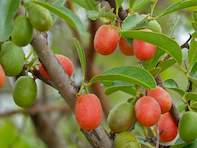The large sourplum Ximenia caffra is a small tree or shrub with orange-red edible fruit and many traditional uses. Often used as a boundary screen in the garden to attract fruit-eating birds and butterflies, it can grow up to 6 m high with spine-tipped branchlets.

The sourplum tree is also known as the wild plum or monkey plum. The sourplum grows in woodlands, grasslands and on rocky outcrops and also grows on termite mounds.
In South Africa the two varieties grow in the northern and central regions of Limpopo (var. caffra) and also in Mpumalanga, Limpopo and KwaZulu-Natal (var. natalensis).
Ximenia is grown easily from fresh seed in a 5:1 mixture of river sand and compost. It is drought-resistant, moderately susceptible to frost and can grow up to 0.5m in a year.
Benefits of Sourplum
Most parts of the sourplum plant are used. A decoction from the leaves is used as an eye-wash, for tonsillitis and to rid the body of parasites. Powdered sourplum leaves are used to treat infertility and fever.
The powdered root are used in soup and beer as an aphrodisiac as well as to heal sores, while a porridge made from the roots can help treat nausea in pregnancy.
The sour fruit is high in vitamin C (27%), is eaten by birds, animals and humans and can be used for jams. The nuts are also eaten. The wood is hard and used to make handles for tools or in construction.
The seed has a high yield (60-70%) of non-drying oil which is cold-extracted. It is rich in mono-unsaturated fatty acids and are used as lamp oil, for softening animal hides and to oil bow strings. Due to its fatty acid composition ximenia oil is also relatively stable to oxidation, has anti-ageing effects and is appreciated for its moisturising properties.
Used as a body and hair oil, it is rich in ximenynic acid which has beneficial effects on skin ageing. Studies on ximenynic acid have revealed improvement in blood circulation. Blood perfusion was increased in a group of female volunteers with cellulite, applying a cream containing 0.5% ximenynic acid.